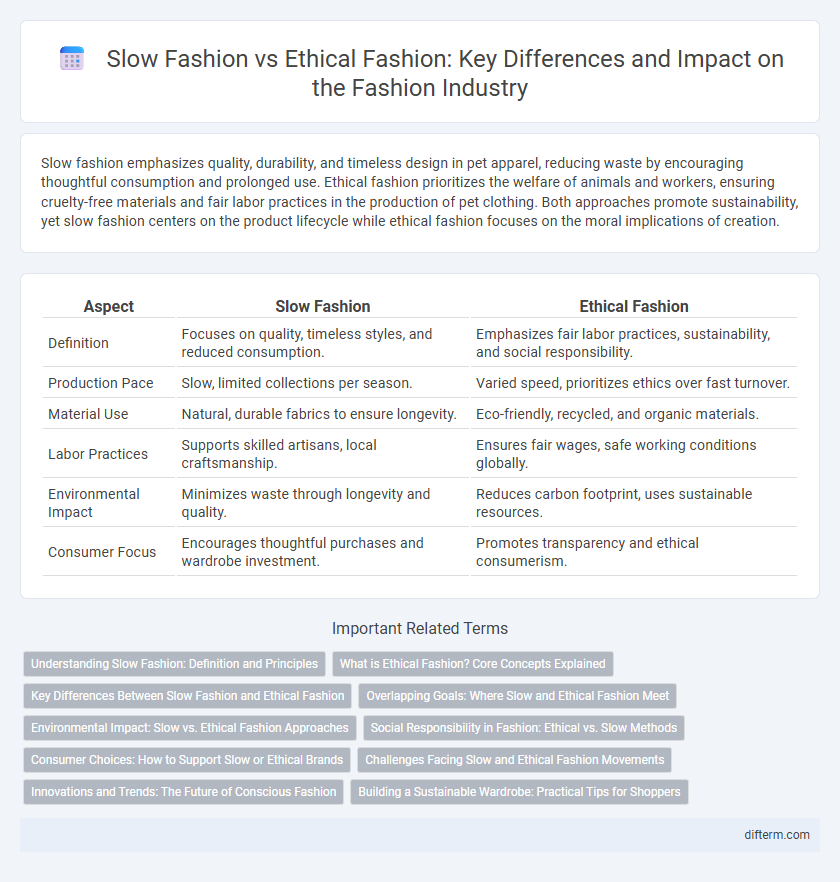Slow fashion emphasizes quality, durability, and timeless design in pet apparel, reducing waste by encouraging thoughtful consumption and prolonged use. Ethical fashion prioritizes the welfare of animals and workers, ensuring cruelty-free materials and fair labor practices in the production of pet clothing. Both approaches promote sustainability, yet slow fashion centers on the product lifecycle while ethical fashion focuses on the moral implications of creation.
Table of Comparison
| Aspect | Slow Fashion | Ethical Fashion |
|---|---|---|
| Definition | Focuses on quality, timeless styles, and reduced consumption. | Emphasizes fair labor practices, sustainability, and social responsibility. |
| Production Pace | Slow, limited collections per season. | Varied speed, prioritizes ethics over fast turnover. |
| Material Use | Natural, durable fabrics to ensure longevity. | Eco-friendly, recycled, and organic materials. |
| Labor Practices | Supports skilled artisans, local craftsmanship. | Ensures fair wages, safe working conditions globally. |
| Environmental Impact | Minimizes waste through longevity and quality. | Reduces carbon footprint, uses sustainable resources. |
| Consumer Focus | Encourages thoughtful purchases and wardrobe investment. | Promotes transparency and ethical consumerism. |
Understanding Slow Fashion: Definition and Principles
Slow fashion emphasizes quality, sustainability, and mindful consumption, encouraging consumers to invest in timeless pieces instead of fast, disposable trends. Its principles prioritize reducing waste, using eco-friendly materials, and supporting fair labor practices throughout the supply chain. Embracing slow fashion fosters a more responsible wardrobe that values environmental preservation and ethical production standards.
What is Ethical Fashion? Core Concepts Explained
Ethical fashion prioritizes fair labor practices, sustainable sourcing, and transparency throughout the supply chain to minimize environmental impact and promote social justice. It ensures workers receive fair wages and work in safe conditions while using eco-friendly materials to reduce waste and pollution. Unlike slow fashion, which emphasizes production pace, ethical fashion encompasses broader responsibilities including animal welfare and community support.
Key Differences Between Slow Fashion and Ethical Fashion
Slow fashion emphasizes reducing production speed and promoting quality over quantity to minimize environmental impact, while ethical fashion prioritizes fair labor practices and social responsibility throughout the supply chain. Key differences include slow fashion's focus on sustainability through durable materials and timeless designs versus ethical fashion's commitment to transparency, fair wages, and safe working conditions for artisans and factory workers. Both movements aim to combat fast fashion, but slow fashion centers on consumption patterns and product life cycle, whereas ethical fashion addresses the human element and corporate accountability.
Overlapping Goals: Where Slow and Ethical Fashion Meet
Slow fashion and ethical fashion share overlapping goals centered on sustainability, fair labor practices, and reducing environmental impact. Both movements prioritize high-quality materials, transparency in production, and mindful consumption to challenge the fast fashion industry's wastefulness. Their common aim fosters a more responsible fashion ecosystem that values longevity and human rights.
Environmental Impact: Slow vs. Ethical Fashion Approaches
Slow fashion and ethical fashion both prioritize reducing environmental harm but differ in approach and focus. Slow fashion emphasizes carefully crafted garments designed for longevity, minimizing waste through quality over quantity, while ethical fashion incorporates broader social responsibility, including sustainable sourcing and fair labor practices. Environmental impact assessment reveals slow fashion reduces landfill waste and resource depletion, whereas ethical fashion drives systemic change by promoting transparency and sustainable production across the supply chain.
Social Responsibility in Fashion: Ethical vs. Slow Methods
Social responsibility in fashion emphasizes ethical practices that ensure fair labor conditions, transparency, and community support, contrasting with slow fashion's focus on reducing waste and extending garment lifespan. Ethical fashion prioritizes human rights and environmental justice, incorporating fair wages and safe working environments in supply chains. Slow fashion complements these efforts by encouraging mindful consumption and durable materials, promoting sustainability through quality over quantity.
Consumer Choices: How to Support Slow or Ethical Brands
Supporting slow or ethical fashion brands requires consumers to prioritize quality over quantity, choosing durable garments made from sustainable materials like organic cotton or recycled fabrics. Researching brand transparency and labor practices ensures purchases align with ethical standards, promoting fair wages and safe working conditions. Opting for local artisans or certified labels reduces environmental impact and fosters responsible consumerism within the fashion industry.
Challenges Facing Slow and Ethical Fashion Movements
Slow fashion and ethical fashion movements face significant challenges including high production costs, limited consumer awareness, and supply chain transparency issues. These obstacles hinder scalability and accessibility, making it difficult for brands to compete with fast fashion's low prices and rapid trends. Overcoming these barriers requires innovative strategies to balance sustainability with affordability and widespread market appeal.
Innovations and Trends: The Future of Conscious Fashion
Innovations in slow fashion emphasize sustainable materials like organic cotton, recycled fabrics, and biodegradable dyes, reducing environmental impact while promoting quality over quantity. Ethical fashion trends integrate transparent supply chains and fair labor practices, leveraging blockchain technology to ensure accountability and consumer trust. Emerging advancements in circular fashion systems encourage garment longevity and recycling, positioning both slow and ethical fashion at the forefront of conscious consumerism's future.
Building a Sustainable Wardrobe: Practical Tips for Shoppers
Building a sustainable wardrobe involves choosing high-quality, durable pieces that reduce the need for frequent replacements, aligning with slow fashion principles. Ethical fashion emphasizes transparency in sourcing, fair labor practices, and environmentally friendly materials, ensuring your clothing supports social responsibility. Prioritize brands that offer timeless designs and certification labels like Fair Trade or GOTS to create a wardrobe that reflects both sustainability and ethics.
slow fashion vs ethical fashion Infographic

 difterm.com
difterm.com